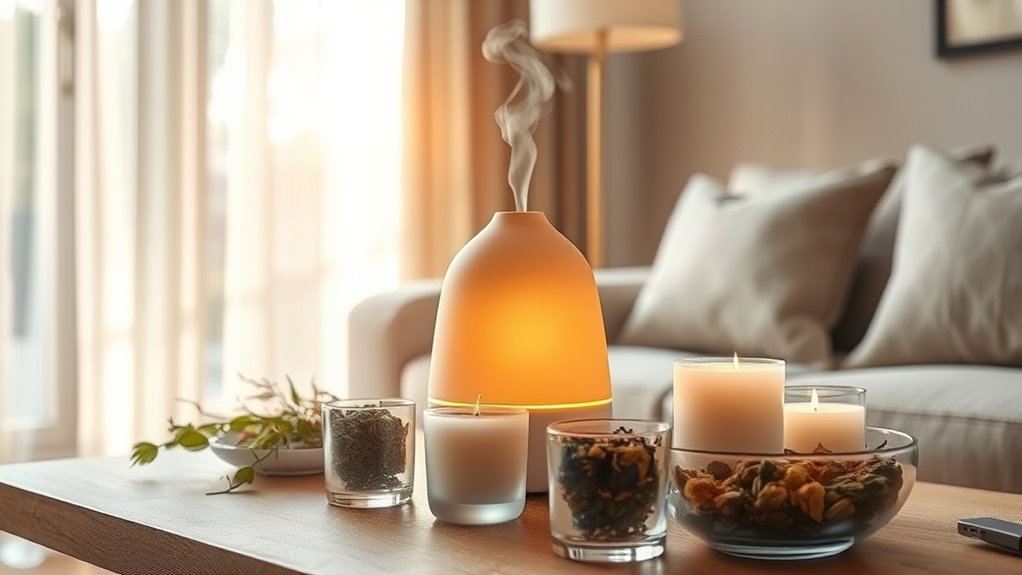By layering scents thoughtfully, you can shape your environment to influence emotions, memories, and perceptions. When you combine fragrances like vanilla for warmth or citrus for energy, you craft a unique signature home aroma that reinforces positive feelings and personal significance. This sensory experience can boost mood, evoke nostalgia, and support emotional well-being. Understanding the psychology behind scent layering helps you create a calming, energizing, or comforting space—explore how to achieve this balance in your environment.
Key Takeaways
- Scent layering influences emotional responses by associating specific aromas with feelings like comfort, happiness, or invigoration.
- Combining fragrances creates a memorable signature scent that enhances personal identity and leaves lasting impressions.
- Layered scents activate the limbic system, shaping moods and reinforcing emotional states within the home environment.
- Understanding scent science allows for intentional design of aromas that support mental well-being and emotional stability.
- Carefully crafted scent combinations transform spaces into mood-enhancing environments, promoting relaxation, focus, or energy.

Scent layering isn’t just about blending fragrances; it’s a powerful psychological tool that influences how others perceive you and how you feel about yourself. When you carefully combine different aromas in your home, you’re creating more than just a pleasant environment—you’re crafting an experience that taps into your deep-seated olfactory memory and emotional associations. These connections are what make your signature scent memorable and uniquely yours. The smells you choose can evoke feelings of calm, happiness, or nostalgia, shaping your mood and even influencing the atmosphere for anyone who enters your space.
Your olfactory memory is incredibly potent because scent is directly linked to the brain’s limbic system, which controls emotions and memories. When you layer fragrances thoughtfully, you’re fundamentally programming your environment to trigger specific feelings or memories. For example, a subtle hint of vanilla can bring a sense of comfort and warmth, while citrus notes might invigorate and energize. Over time, these scented layers become associated with particular moments or states of mind, reinforcing your desired emotional tone whenever you’re in your space. This isn’t accidental; it’s a deliberate act of shaping your environment to support your well-being.
Additionally, understanding the science of scent layering can help you create more effective and personalized olfactory experiences that enhance your overall mood and mental health.
Frequently Asked Questions
How Long Does a Layered Home Scent Typically Last?
Layered home scents usually last around 4 to 8 hours, depending on factors like scent longevity and aroma diffusion. If you use high-quality diffusers or candles, your aroma can linger longer and spread more evenly. To maintain a consistent scent, consider revitalizing or re-layering your fragrances regularly. This way, you can enjoy a welcoming, well-balanced atmosphere that stays inviting throughout the day or evening.
Can Scent Layering Affect Mood and Mental Health?
Scent layering can considerably influence your mood and emotional well-being by creating positive scent associations in your home. When you intentionally combine fragrances, you may evoke calmness, happiness, or relaxation, boosting your mental health. The right scent layers can help reduce stress and enhance your overall sense of comfort. So, your choice of layered scents isn’t just about aroma; it actively shapes your emotional state daily.
What Are Common Mistakes to Avoid in Scent Layering?
When scent layering, avoid overpowering combinations that can become overwhelming or unpleasant. Stay clear of inconsistent themes, which can create a disjointed atmosphere. You should also resist mixing too many scents at once, as it can dilute the intended mood. Instead, choose complementary fragrances and build gradually, ensuring each layer enhances the overall aroma without clashing or overpowering your space.
How Do Seasonal Changes Influence Scent Layering Choices?
Seasonal shifts greatly influence your scent layering choices, as you naturally adapt your home’s aroma to the changing environment. During colder months, opt for warm, cozy scents like cinnamon or vanilla, while spring calls for fresh, floral notes. You should adjust your layers to enhance comfort and reflect seasonal moods. This scent adaptation helps create a harmonious atmosphere, making your home feel welcoming and aligned with the time of year.
Is It Better to Use Natural or Synthetic Scents for Layering?
When choosing between natural and synthetic scents, consider scent authenticity. Natural scents often provide a more genuine, nuanced aroma, making your home feel warm and inviting. Synthetic scents can be versatile and long-lasting, but they might lack the depth of natural fragrances. You decide based on your preference for authenticity versus durability. Mixing both can also create a unique layered scent profile that enhances your home’s ambiance.
Conclusion
Now that you understand the psychology behind scent layering, aren’t you excited to create a home aroma that truly reflects your personality? By thoughtfully combining different scents, you can evoke specific emotions and memories, making your space feel uniquely yours. So, why settle for a generic fragrance when you have the power to craft an inviting, comforting atmosphere that resonates with who you are? Your signature scent awaits—are you ready to make it unforgettable?








